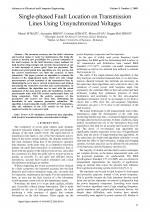| 3/2009 - 10 |
Single-phased Fault Location on Transmission Lines Using Unsynchronized VoltagesISTRATE, M. |
| Extra paper information in |
| Click to see author's profile in |
| Download PDF |
Author keywords
ATP simulation, double-end data algorithm, fault location, transmission lines, unsynchronized voltages
References keywords
power(9), location(9), fault(9), transmission(6), lines(4), dissertation(4), delivery(4)
Blue keywords are present in both the references section and the paper title.
About this article
Date of Publication: 2009-10-26
Volume 9, Issue 3, Year 2009, On page(s): 51 - 56
ISSN: 1582-7445, e-ISSN: 1844-7600
Digital Object Identifier: 10.4316/AECE.2009.03010
Web of Science Accession Number: 000271872000010
SCOPUS ID: 77954730176
Abstract
The increased accuracy into the fault's detection and location makes it easier for maintenance, this being the reason to develop new possibilities for a precise estimation of the fault location. In the field literature, many methods for fault location using voltages and currents measurements at one or both terminals of power grids' lines are presented. The double-end synchronized data algorithms are very precise, but the current transformers can limit the accuracy of these estimations. The paper presents an algorithm to estimate the location of the single-phased faults which uses only voltage measurements at both terminals of the transmission lines by eliminating the error due to current transformers and without introducing the restriction of perfect data synchronization. In such conditions, the algorithm can be used with the actual equipment of the most power grids, the installation of phasor measurement units with GPS system synchronized timer not being compulsory. Only the positive sequence of line parameters and sources are used, thus, eliminating the incertitude in zero sequence parameter estimation. The algorithm is tested using the results of EMTP-ATP simulations, after the validation of the ATP models on the basis of registered results in a real power grid. |
| References | | | Cited By |
Web of Science® Times Cited: 4 [View]
View record in Web of Science® [View]
View Related Records® [View]
Updated 2 weeks, 5 days ago
SCOPUS® Times Cited: 4
View record in SCOPUS® [Free preview]
View citations in SCOPUS® [Free preview]
[1] Estimation of Line Zero Sequence Impedance using Real Field Fault Data for Fault Location Application, Dragomir, Marian, Iamandi, Anamaria, Istrate, Marcel, Dragomir, Alin, Machidon, Dragos, 2019 8th International Conference on Modern Power Systems (MPS), ISBN 978-1-7281-0750-9, 2019.
Digital Object Identifier: 10.1109/MPS.2019.8759762 [CrossRef]
[2] A solution to obtain precise fault location using a two-end data algorithm, Dragomir, Marian, Miron, Alexandru, Istrate, Marcel, Dragomir, Alin, 2016 International Conference and Exposition on Electrical and Power Engineering (EPE), ISBN 978-1-5090-6129-7, 2016.
Digital Object Identifier: 10.1109/ICEPE.2016.7781429 [CrossRef]
[3] Single-terminal Fault Location Algorithm for Electrical Lines, Dragomir, Marian, Iamandi, Anamaria, Rusu, Adrian Constantin, Atanasoaei, Marian, Dragomir, Alin, Adam, Maricel, Andrusca, Mihai, 2019 54th International Universities Power Engineering Conference (UPEC), ISBN 978-1-7281-3349-2, 2019.
Digital Object Identifier: 10.1109/UPEC.2019.8893618 [CrossRef]
Disclaimer: All information displayed above was retrieved by using remote connections to respective databases. For the best user experience, we update all data by using background processes, and use caches in order to reduce the load on the servers we retrieve the information from. As we have no control on the availability of the database servers and sometimes the Internet connectivity may be affected, we do not guarantee the information is correct or complete. For the most accurate data, please always consult the database sites directly. Some external links require authentication or an institutional subscription.
Web of Science® is a registered trademark of Clarivate Analytics, Scopus® is a registered trademark of Elsevier B.V., other product names, company names, brand names, trademarks and logos are the property of their respective owners.
Faculty of Electrical Engineering and Computer Science
Stefan cel Mare University of Suceava, Romania
All rights reserved: Advances in Electrical and Computer Engineering is a registered trademark of the Stefan cel Mare University of Suceava. No part of this publication may be reproduced, stored in a retrieval system, photocopied, recorded or archived, without the written permission from the Editor. When authors submit their papers for publication, they agree that the copyright for their article be transferred to the Faculty of Electrical Engineering and Computer Science, Stefan cel Mare University of Suceava, Romania, if and only if the articles are accepted for publication. The copyright covers the exclusive rights to reproduce and distribute the article, including reprints and translations.
Permission for other use: The copyright owner's consent does not extend to copying for general distribution, for promotion, for creating new works, or for resale. Specific written permission must be obtained from the Editor for such copying. Direct linking to files hosted on this website is strictly prohibited.
Disclaimer: Whilst every effort is made by the publishers and editorial board to see that no inaccurate or misleading data, opinions or statements appear in this journal, they wish to make it clear that all information and opinions formulated in the articles, as well as linguistic accuracy, are the sole responsibility of the author.



